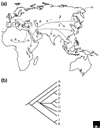Discovering human history from stomach bacteria
- PMID: 12734001
- PMCID: PMC156578
- DOI: 10.1186/gb-2003-4-5-213
Discovering human history from stomach bacteria
Abstract
Recent analyses of human pathogens have revealed that their evolutionary histories are congruent with the hypothesized pattern of ancient and modern human population migrations. Phylogenetic trees of strains of the bacterium Helicobacter pylori and the polyoma JC virus taken from geographically diverse groups of human beings correlate closely with relationships of the populations in which they are found.
Figures



References
-
- Darwin C. The Descent of Man and Selection in Relation to Sex. 6. London: J. Murray; 1872.
-
- Covacci A, Telford JL, Del Giudice G, Parsonnet J, Rappuoli R. Helicobacter pylori virulence and genetic geography. Science. 1999;284:1328–1333. - PubMed
-
- Suerbaum S, Achtman M. Evolution of Helicobacter pylori: the role of recombination. Trends Microbiol. 1999;7:182–184. - PubMed
-
- Achtman M, Azuma T, Berg DE, Ito Y, Morelli G, Pan Z-J, Suerbaum S, Thompson SA, van der Ende A, van Doorn L-J. Recombination and clonal groupings within Helicobacter pylori from different geographical regions. Mol Microbiol. 1999;32:459–470. - PubMed
-
- Falush D, Wirth T, Linz B, Pritchard JK, Stephens M, Kidd M, Blaser MJ, Graham DY, Vacher S, Perez-Perez GI, et al. Traces of human migrations in Helicobacter pylori populations. Science. 2003;299:1582–1585. - PubMed
Publication types
MeSH terms
Substances
LinkOut - more resources
Full Text Sources

